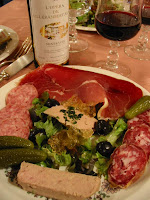Culture shock rushes at you from unexpected angles when you live in a foreign country. You may think living in France, for example, would be challenging due to the language barrier or the fact that people sit at the lunch table for two hours. But one of the greatest differences between American life and French life I had to adjust to was the hours of operation of the grocery stores.
In the States, most larger towns have at least one twenty-four-hour-a-day grocery store. If not, the local grocery store will most likely open before dawn's first light and close well after eleven in the evening. Have a hankering for Ben and Jerry's before bedtime? Don't worry, American grocery stores are happy to accommodate.
In France, however, grocery stores close at 8 p.m, Monday through Saturday. And they remain closed all day Sunday. If you are unaccustomed to this schedule or plan poorly, you may find yourself eating whatever you have in a can at the back of the cupboard, or dry cereal, until Monday morning.
One Saturday back in 1997 when two of my sisters were visiting me in Auch, we took a bus and spent the day sightseeing in Toulouse. The last bus back would have us arriving at 8:30 in the evening, and I realized we'd need to hit the grocery store in Toulouse before boarding.
We rushed through a small store near the terminal, grabbing the ingredients for Poulet á la Crème. With just minutes to spare, we clambered onto the bus with bulging bags of mushrooms, fresh thyme, crème fraiche, baguettes, and (I kid you not) a whole, raw chicken.
The forty-five minute ride home was jovial, and as luck would have it, the three of us were the last of the passengers to disembark in Auch. Weary from a day in the sun and lots of unbridled laughter, we trudged down the last cobblestoned road to my apartment.
I pulled pots and pans from the cupboard as my sisters unloaded the bags.
Natasha said, "Nick, where's the chicken?"
"Natalie has it," I answered, blowing a wisp of hair out of my eyes.
We both looked over at Natalie, whose eyebrows arched slightly higher than normal. "Um, I thought one of you had it."
Apparently, we'd all made it off the bus except the chicken. Hopefully, the bus driver found it before his next morning run.
My sisters didn't understand my dismay, until they brightly suggested we could just order take out.
"This is France," I groaned. "The gastronomical epicenter of the world. There is no take out." I anticipated the next question and said, "No, not even pizza."
It was their last night in France, before taking the train to Paris the next morning to catch a flight out. And we ate cold cereal and milk. But I lit candles. And it was France, for pete's sake!
Nicole, Natasha, and Natalie (1997)
Bonne Journée!
Leave me a comment and earn one entry in my Vive la France! Contest.
Click here for full contest details.
Leave me a comment and earn one entry in my Vive la France! Contest.
Click here for full contest details.











































